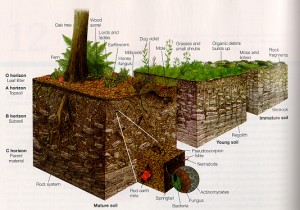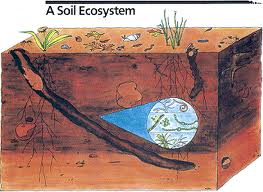In point of view of the agriculture or cultivation, soil plays a very important role. It has to be nourished and treated well in order to obtain the best produce. Soil ecology is basically a study which involves any interactions between the living organisms and also deals with the biotic and non biotic aspects of the environment.

The vast spread of the pathogens and their preponderances in modern day agriculture, the pore structure study, the biological community are all the various branches of this study.
Soil is a concoction of several things be it, the dead and decaying organic matter, small weathered particles and many other nutrients too. It has large amount of chemical, physical and any other biological entities interspersed in it.
The soil food web!

There are quite a number of organisms that reside in soil. Some of them being, protozoa fungi, bacteria and also insects, earthworms etc.
These soil organisms are very essential in improving the nutrient content of soil. They also help in fixing the nitrogen from the atmosphere and making it available in the soil for the growth of plants.
Contents of soil:

Soil is a mixture of several minerals like sand, silt, clay and also organic matter.
There is also a soil textural triangle which is composed of silt, clay and sand in proper proportions. 0.05 to 2 km are the sand particles, 0.002 to 0.05 mom are silt particles and 0.002 mm are clay particles. Sandy loam is basically 70 percent sand, 10 percent clay and 20 percent silt.
The soil processes:
The numbers of chemical and biological processes that occur in soil are too many. Fixation of atoms of the mineral matter into organic compounds and mineralization of organic matter are some of these processes.
The organic matter content in soil:
This is one of the extremely important parts of the soil or in general the eco system. Soil organic matter is one of the main sources of food for the organisms living in soil. When they consume them, they release phosphorus, sulphur, nitrogen which are inorganic nutrients.
Moreover, to maintain the quality of the soil, the soil organic matter needs to be properly replenished.
There are a number of components that are readily available in soil. They are:
1) Phosphorous:
This helps in the growth of the plant and also hastens the maturity. This is the main content of the manure that is available from the grain-fed animals.
2) Nitrogen:
It is very essential in the growth of plants and their cell tissues especially. It also helps in making the nitrogen present in atmosphere to be readily available in the soil through crops like legumes.When absorbed by the soil, this nitrogen turns out to be nitrate. But, nitrogen maybe leached or washed out from the soil by heavy rain. This unfortunately may result in soil acidification.
3) Calcium:
It is very important for the growth of plants , their roots and root hairs. The main sources of calcium are super phosphate, lime and gypsum.
4) Magnesium:
It is a very essential part of the photosynthesis mechanism. Excessive potassium in the soil can cause magnesium deficiency too. But, this deficiency can be easily overcome with the help of dolomite, Epsom salts or even magnesite.
5) Potassium:
It makes the plants disease-resistant and enables healthy growth of the plants. The best sources of potassium are Muriate of potash and sulfate of potash.
Moreover, apart from these elements, there are traces of several other elements too. Some of them are here as follows:
1) Molybdenum: It makes the nitrogen in the atmosphere to be available at the roots of the plants, like legumes.
2) Manganese: It is one of the most important factors that help in photosynthesis. It is found in areas where there is high degree of acidification or toxicities.
3) Zinc: This is very essential for the development of leaves and also the elongation of the stem. So, basically it helps in the overall growth of the plant.
Soil is made up of several layers which are called as ‘horizons’.

1) The first layer being organic matter. This is called the top soil and is the best for agriculture and is highly suitable for cultivation. Since organic matter is present, this layer is called as ’humus’. This is region ‘A’.
2) The second horizon is ‘B’.This region has very little of organic matter when compared to horizon ‘A’. It also contains many of the soluble materials.
3) The third horizon is’ C’. This mainly contains of broken up bedrock materials and is found deep under the ground.
These layers of soil are generally formed due to the various chemical, biological and other atmospherics conditions too. The entire process wherein the bigger rocks are broken down into smaller particles is called as weathering. Weathering is also a continuous process of several chemical and biological conditions that naturally occur.
Thus, now we can surely say that the soil not only provides a base for the agricultural practices but also provides the essential nourishment for the plants. Moreover, it also provides sufficient nutrients and helps in the growth of a greener planet!


Leave a Reply